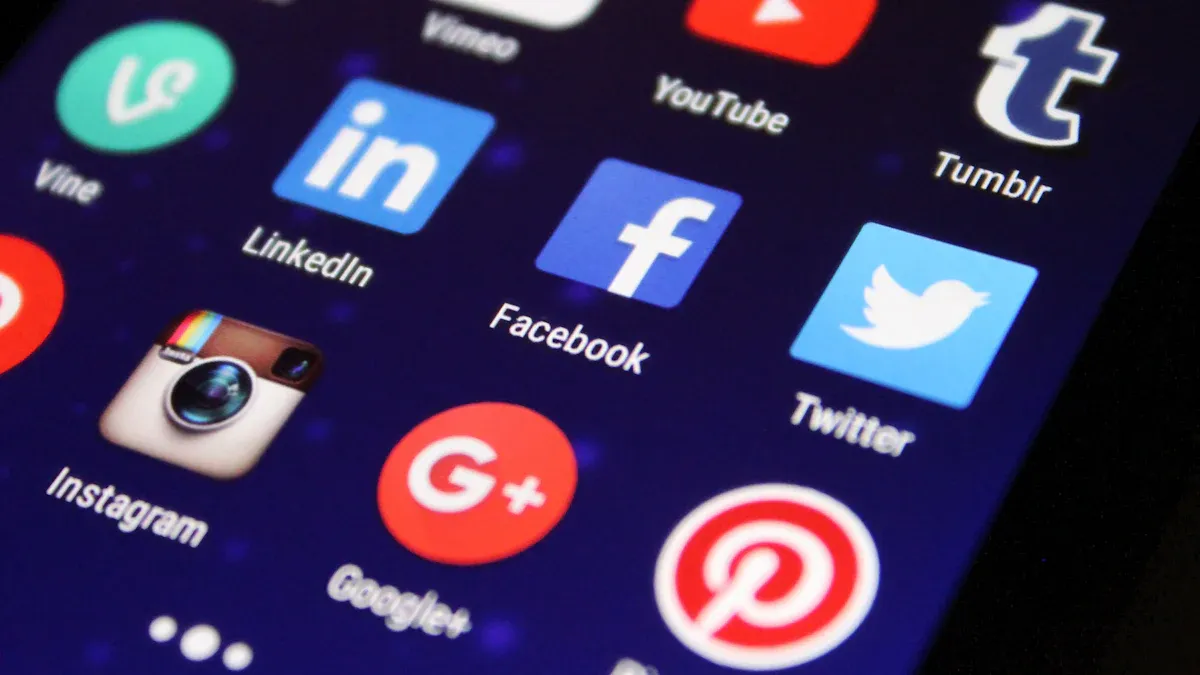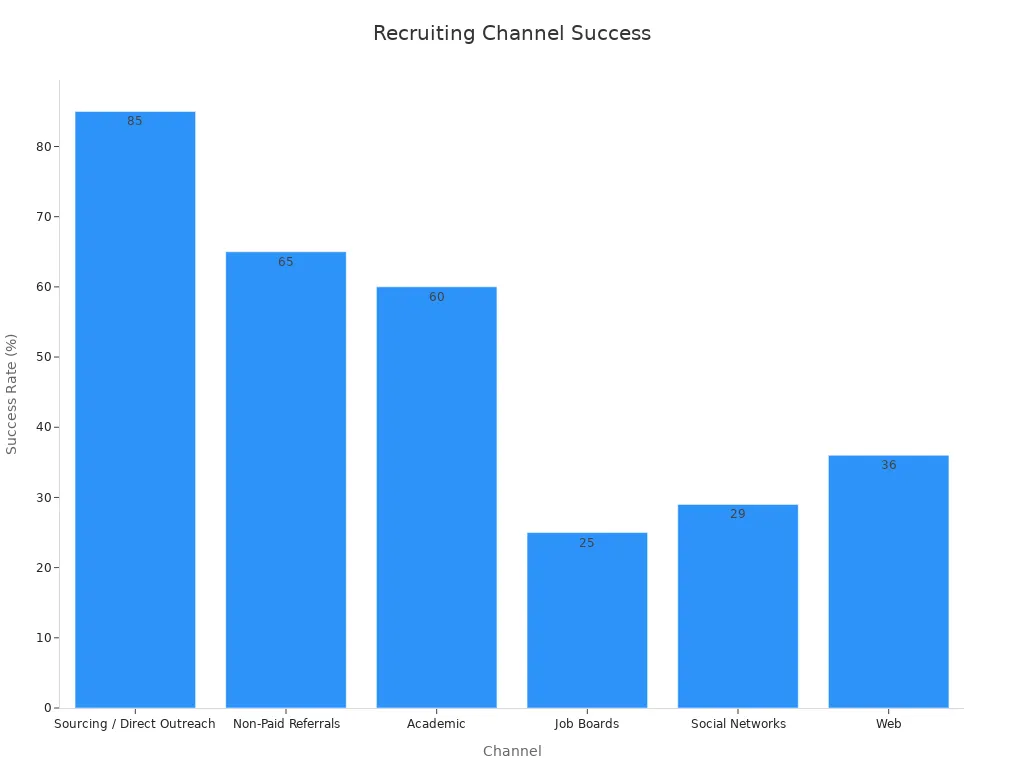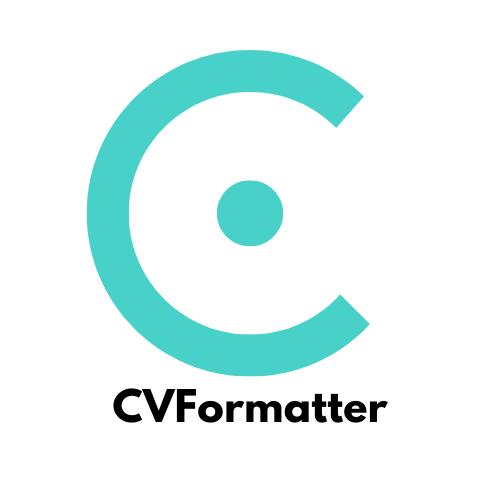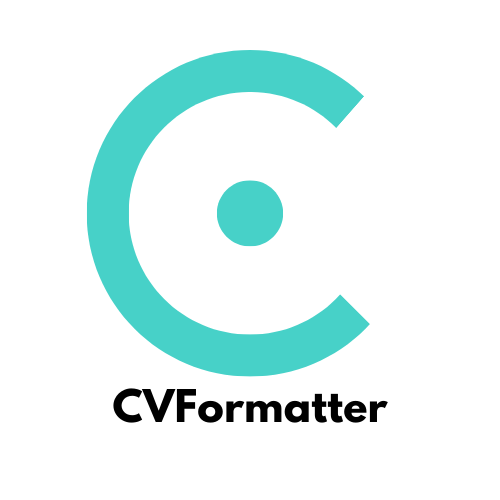The Role of Social Media in Modern Recruitment Marketing

Social media has changed how companies hire workers. It’s not just for chatting with friends or sharing pictures anymore. Now, it’s a strong tool to find great employees. Did you know 94% of recruiters use LinkedIn, Facebook, and Twitter to find workers? Job seekers also use social media, with 79% searching for jobs there. This change makes social media important for hiring today. It helps companies find the right people faster and easier. You can use it to share job ads, show your company’s values, or reach people not actively looking for jobs. Adding social media to hiring plans can bring amazing results.
Key Takeaways
Social media is important for hiring. 94% of recruiters use sites like LinkedIn and Facebook to find workers.
Ads on social media help find the right people fast. This makes more people apply for jobs.
Posting about your company’s culture and worker stories builds trust. It also attracts new job seekers.
Talking to people through fun posts and live chats helps hire better workers.
Asking employees to share job openings online reaches more people. It also makes your company look better.
Expanding Reach with Social Media

Social media has changed how we find job candidates. It’s not just for posting job openings anymore. Now, it helps you connect with many people. This includes those from different places and those not job hunting. Let’s see how social media helps you reach more people.
Finding talent worldwide
Platforms like LinkedIn and Facebook make the world feel smaller. You can meet skilled workers from anywhere without traveling. This is great if you need special skills or want a diverse team.
Here are some quick facts about social media and hiring:
79% of job seekers use social media for job searches.
60% of companies use social media as their main hiring tool.
These numbers show why social media is so important. It lets you look beyond local talent and find people everywhere.
Connecting with diverse groups
Diversity means having different ideas and experiences on your team. Social media helps you find people from all kinds of backgrounds. Platforms like Twitter and Instagram connect you with groups not on regular job sites.
For instance, hashtags like #WomenInTech can help you find diverse candidates. LinkedIn groups also introduce you to underrepresented professionals.
Using social media for diversity shows your company cares about inclusion. It also helps you hire amazing talent.
Using each platform wisely
Every social media platform has a unique audience. Knowing this helps you find the right candidates.
LinkedIn: Best for finding experienced professionals and networking.
Facebook: Good for reaching a wide range of job seekers.
Instagram: Great for showing your company’s culture to younger people.
Here’s how recruiters view social media’s importance over time:
Year | Percentage of Recruiters Seeing Social Media as Important |
|---|---|
2024 | |
2023 | 83% |
As you can see, more recruiters value social media for hiring. By using each platform smartly, you can find the best candidates.
Employer Branding Through Social Media

Social media isn’t just for posting job openings. It’s also a great way to show your company’s personality. When used well, it can attract good workers and build trust. Let’s see how social media can make your company stand out.
Sharing Company Culture
Your workplace has its own special vibe. Social media lets you share this with others. You can post stories about your team or share videos of daily work life. These posts help people imagine working at your company.
For example:
Posting about flexible schedules shows you care about balance. Companies with flexibility often keep workers longer.
Highlighting employees can show how your team grows and succeeds.
These posts don’t just promote jobs—they show why people would enjoy working with you.
Earning Trust from Job Seekers
Trust is key when hiring new workers. People want to join companies that value them. Social media helps you build trust by being open and honest.
Here’s how to check if your efforts are working:
Metric | What It Shows |
|---|---|
How many people apply for your jobs. | |
Time-to-fill | How fast you hire for open positions. |
Candidate quality | How happy managers are with new hires. |
How long workers stay at your company. | |
Brand sentiment | What reviews and social media say about your company. |
Referral volume | How many workers recommend others to apply. |
Tracking these numbers shows how strong your company’s image is. When people trust your brand, they’re more likely to apply and tell others about it.
Boosting Branding with Employee Stories
Your workers are your best cheerleaders. When they share their experiences online, it makes your company look real. People trust honest stories more than fancy ads.
Here’s why employee stories matter:
They act as proof. Workers sharing good things about your company builds trust.
They make your company relatable. Real stories feel more personal.
They show honesty. Open posts from workers prove your company is genuine.
Today, job seekers often check social media to learn about companies. If workers’ posts match your company’s image, it builds trust. But if they don’t, it can hurt your reputation. Encourage your team to share their true experiences—it helps everyone!
Targeted Advertising on Social Media
Using social media ads is a smart way to hire. It helps you find the right people quickly and easily. Let’s see how these tools can help you attract great workers.
Using advanced targeting tools
Social media platforms have tools to focus on specific groups. You can choose by location, job type, skills, or hobbies. This means your ads reach people who might actually apply.
For example, LinkedIn lets you target workers in certain fields or with special skills. Facebook and Instagram let you create groups based on interests or habits. These tools save money and make your ads work better.
Here’s how these tools help:
Metric | What It Shows |
|---|---|
Click-through rates | How many people click on your ad. |
Cost-per-click | How much you spend for each click. |
Audience segmentation | How well you can send messages to specific groups. |
Using these tools ensures your ads connect with the right people.
Creating tailored job ads
Basic job ads don’t grab attention. Custom ads, however, stand out more. When your ad feels personal, it gets noticed.
Think about how your ad looks and sounds. Want creative workers? Use bright pictures and fun words. Need executives? Keep it simple and professional. Instagram is great for showing your company’s vibe, while LinkedIn works for detailed job info.
Custom ads also show what makes your company special. Talk about flexible hours or chances to grow. This not only gets people interested but also makes your company look good.
Measuring ad performance
Checking how your ads are doing is very important. It shows what’s working and what needs fixing. Start with key numbers like click-through rate (CTR) and conversion rate. CTR shows how many clicked your ad. Conversion rate shows how many applied for the job.
Other numbers to watch:
Bounce rate: How many leave quickly after clicking your ad.
Impressions: How often your ad is shown.
Cost per click (CPC): How much each click costs you.
Campaign Goal | |
|---|---|
Get Website Visitors | Number of Visitors, CTR, Bounce Rate |
Find Job Applicants | Leads, Conversion Rate, Cost per Lead |
Boost Engagement | Likes, Shares, Comments, Engagement Rate |
By studying these numbers, you can improve your ads and get better results. Social media ads aren’t just about reaching people—they’re about reaching the right ones.
Finding Candidates with Social Media
Social media is great for finding skilled workers. With billions of users, platforms like LinkedIn, Facebook, and Twitter help you connect with many people. Let’s see how to use these platforms to find the best workers.
Using LinkedIn to Find Workers
LinkedIn is a favorite tool for recruiters. About 87% of them use it to find workers. It has tools like search filters and InMail messages to help. You can search by job title, skills, or location to find the right person.
Track your LinkedIn success with these numbers:
Metric | What It Tells You |
|---|---|
Profile Views | Shows how many people check your profile. |
InMail Response Rate | Tracks how many people reply to your messages. |
Connection Growth Rate | Shows how fast your network is growing. |
Job Post Engagement | Measures likes, comments, and shares on your job posts. |
Applicant Quality | Checks how well candidates fit your job needs. |
Watching these numbers helps you see what works and what doesn’t.
Using Hashtags and Groups
Hashtags and groups are helpful for finding workers. Hashtags like #TechJobs or #MarketingCareers make your posts easier to find. On Twitter, hashtags also let you join chats and meet professionals.
Groups on Facebook and LinkedIn are also useful. They let you talk to people in specific fields. For example, joining a group for designers can help you find talented workers who aren’t job hunting.
Tool | How It Helps |
|---|---|
Hashtags | Makes posts more visible and connects you with job seekers. |
Social Media Groups | Lets you talk directly to people in specific industries. |
Using these tools helps you find workers you might miss otherwise.
Reaching Out Directly
Some of the best workers aren’t looking for jobs. That’s why direct messages work well. LinkedIn lets you send personal messages to potential workers. This method works 85% of the time, better than job boards.
Here’s a chart showing how different hiring methods compare:

When messaging, keep it short and personal. Mention something specific about their profile, like a skill or project. This makes your message stand out from others.
Engaging Passive Candidates on Social Media
Making interesting posts
Some posts grab attention, while others don’t. That’s why making interesting posts is important. To connect with passive candidates, share posts they enjoy. Post things like your company’s wins, employee stories, or fun behind-the-scenes moments. These posts make your company seem friendly and real.
Here’s why this works:
95% of people trust posts from companies they follow.
Companies with strong brands get twice as many job applications.
Longer posts often get shared more, helping you reach more people.
LinkedIn is great for this. It creates 80% of business leads, making it perfect for finding passive candidates. Focus on making posts that are helpful and easy to share.
Building connections
Passive candidates aren’t looking for jobs, but they might still be interested. To connect with them, start small. Like their posts, leave nice comments, or share their content. These actions show you respect their skills.
Timing matters too. People check messages at certain times, so send yours when they’re online. Personal messages also help. Mentioning their skills or work in a subject line can make them open your email. It’s all about showing you notice and value them.
Telling stories well
Stories are easy to remember and make people feel something. Use them to connect with passive candidates. Share stories about your team solving problems or an employee’s success at your company. These stories show what it’s like to work with you.
Real employee stories are powerful. Interviews or posts about fun places near your office can make your company more appealing. If your company cares about the environment, share how you’re helping. These stories attract people who share your values and build a sense of belonging.
Tip: Add fun things like polls or Q&A sessions to your stories. They make your posts more exciting and get people involved.
Networking and Referrals on Social Media
Social media makes it simple to connect and share. It’s not just for job ads anymore—it’s about building relationships. Let’s see how social media can grow your referral network.
Getting employees to share
Your workers can help spread the word. When they post job openings or talk about your company, it reaches their friends. This builds trust and attracts people who might not see your ads.
Here’s why employee sharing works:
Fact | Why It Matters |
|---|---|
Social media reaches many people, perfect for job sharing. | |
Friends trust friends | Employee referrals feel more honest than regular job ads. |
Employees know your culture | Their referrals often match your company’s values. |
Sharing boosts teamwork | A sharing culture makes employees more involved. |
Rewards encourage sharing | Thanking employees for referrals increases participation. |
Ask your team to share jobs and their work stories. A single post can reach many new people.
Joining groups to connect
Groups on LinkedIn and Facebook are great for meeting others. They bring together people with similar interests, making it easy to find candidates.
Here’s how social media helps networking:
Talking to the right people builds strong connections.
Sharing useful posts earns trust and leads to referrals.
Helping others encourages them to return the favor.
Join groups in your industry and start chatting. Share tips, answer questions, and make friends. These actions can lead to referrals and lasting connections.
Creating referral programs
A good referral program can improve hiring fast. Use social media to promote it and make it easy for workers to join. Offer rewards like bonuses or praise for successful referrals.
Reaching out directly also helps. When workers recommend someone, it builds trust. People believe recommendations more than ads, so this boosts your company’s image.
Keep your referral program simple and rewarding. When workers feel appreciated, they’ll share more job openings with their networks.
Screening Candidates Using Social Media
Social media helps you learn about candidates before hiring. It gives a peek into their work and personal traits. But how can you use it the right way? Let’s explore.
Checking profiles for details
Social media profiles show more than just skills. You can see creativity, communication style, and teamwork. These details help you decide if they fit your company.
Here’s what managers often notice:
Posts showing teamwork or leadership skills.
Content matching the candidate’s values and interests.
Warning signs like bad behavior or misconduct.
Numbers also show how useful social media screening is:
Metric | What It Shows |
|---|---|
Misconduct Identification | |
Hiring Manager Findings | 85% of managers found reasons to reject a candidate through social media. |
Quality of Hire Metrics | Retention rates, performance scores, and cultural fit ratings. |
Recruitment Metrics | Cost per hire, time to fill, and engagement rates. |
Looking at profiles can reveal things resumes might miss.
Being fair and ethical
Using social media for screening needs fairness. Avoid judging people for their opinions or lifestyle. Focus only on job-related traits and actions.
Be honest with candidates about your process. Tell them if you’ll check their profiles. This builds trust and shows your company values honesty.
Respecting privacy
Privacy is important when checking social media. Only look at public posts, not private accounts. Respecting privacy protects candidates and your company’s image.
Tip: Make clear rules for social media checks. Decide what’s okay to review and what isn’t. This keeps your hiring process fair and consistent.
Social media is helpful for screening, but it must be used carefully. When done right, it helps you find workers who match your company’s goals and values.
Real-Time Interaction on Social Media
Talking to people instantly on social media is a big deal. It helps you connect with job seekers quickly and makes things more personal. Let’s see how live chats, Q&A sessions, and fast replies can help you.
Chatting live with job seekers
Live chats let you talk to job seekers right away. You can answer their questions, share job details, and help them apply. This quick connection makes your company seem friendly and helpful.
Here are some things to check for live chat success:
What It Means | |
|---|---|
Engagement Rate | How often people use the chat. |
Response Time | How fast you reply to messages. |
Satisfaction Ratings | How happy people are with the chat. |
Number of Interactions | How many chats happen with each person. |
Conversion Rates | How chats lead to applications or interest in jobs. |
Watching these numbers shows what’s working and what needs fixing. Being quick and kind in chats leaves a good impression.
Running Q&A sessions
Q&A sessions on Instagram Live or LinkedIn Live are great for talking to job seekers. You can answer their questions and show what your company is like. Talk about things like your workplace, career tips, or how to do well in interviews.
To make these sessions work, tell people about them early. Post reminders and ask for questions before the session. During the live event, keep it fun and easy to follow. This builds trust and helps people learn more about your company.
Replying quickly to messages
Answering messages fast shows you care about people’s time. Whether it’s a comment or a direct message, replying quickly keeps the conversation going. This can help you build stronger relationships.
Turn on notifications so you don’t miss messages. If you can’t reply right away, let them know you’ll respond soon. Even a short reply can make a big difference.
Real-time interaction on social media isn’t just about being there—it’s about acting fast. By using live chats, hosting Q&A sessions, and replying quickly, you can connect better with job seekers.
Promoting Job Postings on Social Media
Social media makes sharing job ads much easier. It’s not just about posting links. It’s about showing jobs to the right people. Let’s see how to make your job ads stand out.
Making job ads more visible
Paid ads on social media help job posts get noticed. Platforms like LinkedIn and Facebook let you target specific groups. You can choose by location, skills, or hobbies. This way, your ad reaches people who might apply.
Promoting jobs increases how many people see them. Studies show it can boost applications by up to 50%. When others share your post, even more people see it. This creates a chain reaction. Social media also gives you data to see what works best. Use this info to improve future ads.
Posting in the right groups
Social media groups are great for finding workers. LinkedIn and Facebook have groups for different careers. Sharing job ads in these groups connects you with the right people.
For example, if you need tech workers, post in coding groups. These groups already have skilled people. Being active in these spaces builds trust and makes your posts stand out.
Getting others to share
When others share your job ads, it feels more real. People trust posts from friends more than ads. Ask your team to share job openings or talk about their work. A single post can reach hundreds of new people.
You can also run fun campaigns to get followers involved. Ask them to share why they like your company. These posts promote jobs and make your company look great.
Social media has changed how companies hire workers. It helps you reach more people, share your company’s values, and find great employees. Here’s why it works so well:
It helps you find the right workers faster.
A good social media profile makes your company look better.
Ads and quick replies keep job seekers interested.
Using social media smartly makes hiring easier and better. Start using it today to find awesome workers!
See Also
The Success of TikTok in Recruitment for Agencies
Maximizing LinkedIn Recruiter Tools for 2025 Success
Your Complete Guide to 360 Recruitment Strategies 2025
Essential Recruitment Trends to Watch in 2025
Strategies for Managing a Successful Recruitment Agency 2025

